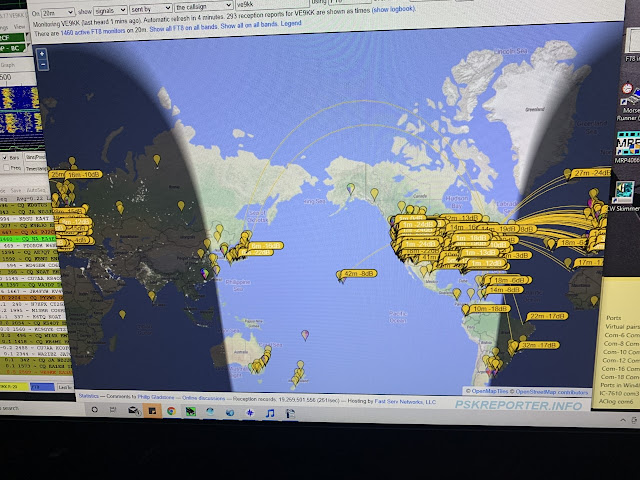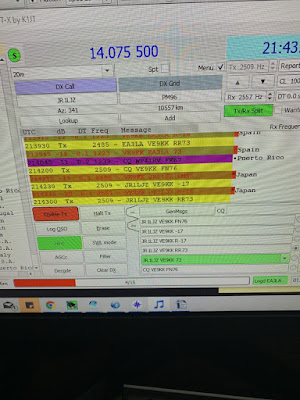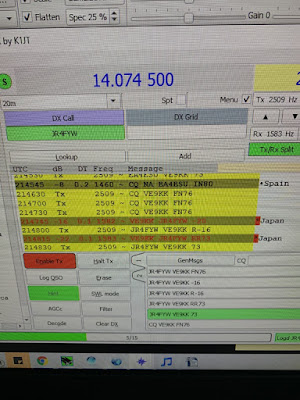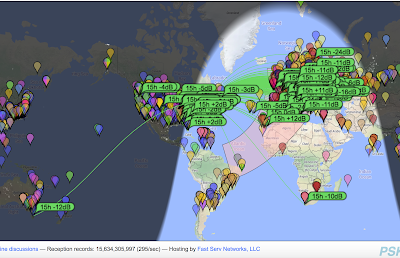Posts Tagged ‘ft8’
 A nice FT8 afternoon.
A nice FT8 afternoon.
I was on the radio this afternoon and decided to give FT8 a try on 20 meters. I made some contacts in the U.S., France, Germany and Spain. Then out of the blue, I had a station from Japan call me and I did not notice any J stations I was decoding but I was very pleased regarding the contact. Then once again out of nowhere another J is calling me and I made my second contact. I took a look at PSK reporter to see where my FT8 signal was being spotted. I was shocked to see not only Japan but also Hawaii. A very nice time on the radio today.
 Some 6m Summer Excitement
Some 6m Summer Excitement

With three seasons of FT8 under its belt, there’s no doubt that it's taken over as the number-one mode for the 6m band ... there are very few traces of CW or SSB to be found.
What it hasn’t taken away, is the magic!
For the most part, this summer’s conditions from the west coast were pretty normal, except for when they weren’t ... and when they weren’t, they were pretty spectacular!
The spectacular parts were highlighted by one particularly unique contact that can only be attributed to some heads-up operating skills, a little help from FT8 ... and the unpredictability of Sporadic-E.
On June 20, at 0056Z, K7CW (Paul), south-west of Seattle, nudged his signal all the way to Hong Kong, more specifically, to VR2ZXP’s crowded apartment building. But that’s not the incredible part. That happened when Paul heard and exchanged signal reports with Alfred’s tiny station!
 |
| Paul, K7CW |
 |
| Not the best location for weak signal 50MHz DX! |
"As I told to Paul, it’s a hard job to be a ham in VR2 Hong Kong especially for the DX. Hong Kong is a high density population city. 99% people are living in apartment only. The housing price here is crazy around US$1800 per sq. feet. Neighborhoods always complain why we setup antennas out of our windows and produce radiation to affect their health. So, what we just can do is to use a small whip with QRO for the QSO. Besides, interference is also serious. Thousands of air conditioner is surrounding me and a power station 132kV to 11kV is just faced to me in 1km away. Here the noise level on low HF band at night is S9."
As indicated above, Alfred’s station is located in a typical high-rise apartment, surrounded by numerous others, with no room for antennas. His solution is to clip a short (60”) whip antenna, horizontally mounted on his balcony railing, similar to this one from 20 years ago ... before being surrounded by noisy high-rise apartment buildings!
I’m not sure which is the most spectacular part of this contact ... that Alfred could detect Paul’s signal in such a noisy environment using such a small makeshift antenna or that Paul was able to copy the tiny signal coming from uptown Hong Kong.
 |
 |
| K7CW's 9el - 50' Yagi at 80' |
Long openings like this occur very rarely, making them even more thrilling and can cause even the most experienced 6m DXer’s mouse-hand to tremble with excitement!
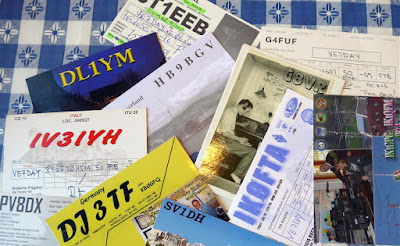 |
| Some of VE7DAY's wallpaper from the May 31st opening. |
Others up and down the west coast also filled their log pages with ‘new ones’ ... unfortunately my exciter was on the workbench while replacing the screen so I never knew what I had missed until some time later ... probably just as well. I guess I must have been pretty naughty at some point, as the 6m gods definitely singled me out for special punishment that morning.
Once the exciter was back together I was able to catch a few good openings myself, the best of which was early on the morning of June 23 when I was able to work SV9CVY (Crete), SV1DH (Greece) and IS0AWZ (Sardinia).
Crete and Sardinia gave me DXCC #89 and #90. Three days later, during a nice opening to the southern states, J68HZ in St. Lucia snuck through the QRM for #91. After a further three days, on June 29, another very early opening put 8 more Europeans in the log including HA8CE (Hungary) and YU7EF (Yugoslavia) for #92 and #93 respectively.
The band also produced several long openings to Asia, usually in the late afternoon hours. Several contacts were made with South Korean stations, China and dozens with Japan.
All told, the band produced some exciting activity this summer. Countries worked here were:
JA, JW, TG, V31, J68, LA, SM, SV9, SV, IS0, EA, HA, YU, F, 9A5, BG, HL, EA8. Certainly FT8 had much to do with a good portion of the action but it is difficult to say just how much. Many of the Europeans were very strong and could have easily been worked on CW in a matter of a few seconds, rather than the 60 - 75 seconds required for a valid FT8 exchange, assuming there are no repeats. But it's contacts like Paul and Alfred's that continue to validate the special name given to the band ... you just never know what might tricks will be next.
 FT8 And The Magic Band
FT8 And The Magic Band

Today’s blog is directed to those that may be new to 6m or new to using FT8 on 6m. Some of the things discussed will make your experience on the magic band better for you and better for your neigbours.
Unlike using FT8 on the HF bands, 6m presents some different challenges, especially if you operate in a region where there may be a lot of other locals also using the band at the same time.
Although the weak-signal capability of FT8 has made it possible for many smaller stations or those with makeshift antennas to take advantage of the unique propagation 6m has to offer, it also can create problems for other users of the band when used inappropriately. In regions of dense population, even small stations can create very high local signal levels, often making it impossible for their neighbours to hear weak signals. This is not deliberately-caused QRM but arises when some operators operate 'against the flow’ and transmit on the opposite ‘sequence’ to everyone else in their local area.
On HF, one can transmit or listen on whatever time sequence they wish. Chosing ‘TX 1st’ or ‘TX 2nd’ is usually determined by who you hear calling CQ or who you wish to work. On 6m however, in a densely-populated region of local operators, chosing to transmit whenever you want to is a luxury that can create big problems for your neighbour who may be trying to hear that weak DX signal while you are transmitting!
These problem will not occur if everybody in the region uses and follows the same transmit-receive periods, so that everyone is listening or everyone is transmitting at the same time ... one or the other. Unfortunately, this ‘ideal’ system falls apart easily when one or more of your neighbours is not using the same sequence as everyone else.
For the past few years, a protocol that seeks to alleviate this problem has become popular and well accepted by those familiar with it. Those new to 6m may not know about it or understand the reasoning behind it.
Above all, I would urge new users of the band, or to the FT8 mode, to first listen carefully for a few minutes, before beginning operation, to determine what the majority of stations in their local region are using for sequencing. If they are using ‘TX 1st’, then your choice of ‘TX 2nd’ will likely cause hearing difficulty for many others, as well as for yourself.
Although there are no strict rules, there is a very successful and well-practiced protocol, and that is that the ‘easternmost’ station transmits on ‘1st’ while the ‘western end’ goes 2nd’. This is why you will hear most eastern stations in the morning hours transmitting ‘2nd’, as they are usually calling or looking for Europeans to their east, who are transmitting ‘1st’. By the same token, you will also hear western stations transmitting on '2nd', who are also looking for Europe to their east, transmitting on ‘1st’.
This sequencing protocol usually reverses later in the day when signals from Asia become a possibility, and all North Americans then become the ‘easternmost’ stations and will transmit on the ‘1st’ sequence ... unlike in the morning. I can easily see how newcomers to the band could become confused, when they hear both sequences being used! The best thing, once again, is to listen carefully first and then ‘go with the flow’.
You can read about the UK's Six Metre Group's initiatives regarding these protocols HERE.
OK... so you’re not interested in EU or Asia? Then it shouldn’t matter to you which sequence that you use and best operating practice would again be to ‘go with the flow’ in consideration of other users.
A few days ago I saw a prime example of exactly what not to do, in too many respects. I made a posting on the ON4KST 6m chat page that VE1SKY in NS (Nova Scotia) was being decoded here, mainly to alert others in my region that European signals might be coming next, as hearing the VE1s in BC is often an indicator that the European path is building.
In less than a minute, an S9+ local began calling ‘CQ NS’ on the exact opposite sequence of all others ... effectively blocking the waterfall and any possible hope of hearing weak EU signals. I’m sorry, but this is just terrible operating procedure, with almost zero chance of success, while showing no consideration for nearby users.
Just like working DX on CW or on phone, the best way, as it always has been, is to ‘listen, listen and then listen some more’. You will work FAR more DX by listening and calling at the right time, than you will by calling CQ.
I also see some local stations everyday, calling endless CQs, often for over 60 minutes straight and often with many replies that go unnoticed. With FT8, one can check ‘work 1st’, go away, and return later to see who they might have ‘worked’. Perhaps this is what these operators are doing, but they should understand that they are also creating non-stop QRM for other users ... those that choose to listen carefully to the band rather than to endlessly CQ. Once again, this is just poor practice.
You may argue that if nobody called CQ, then there would be no contacts made. There is nothing wrong with a few CQs but CQing for an hour? And don’t worry, there will always be other stations CQing endlessly for you to hear, even if it’s not a great way to operate.
With a little pre-planning for sequencing and consideration for your neighbours, everyone can and should be able to enjoy 6m FT8 with very few problems ... and that is my hope for all of us.
After forty-eight summers of CW and phone on 6m and two summers on FT8, these are some of my initial thoughts on how to best operate for maximum success and consideration for other band-users.
The latter is part of the basic framework upon which amateur radio was originally established, when back in 1914, the ARRL described in their 'Code of Conduct' for amateurs ... "The Amateur is Gentlemanly. He never knowingly uses the air for his own amusement in such a way as to lessen the pleasure of others."
Now, let the magic, and the pleasure, continue!
 One Aspect of Amateur Radio: Good Will Ambassadors to the World
One Aspect of Amateur Radio: Good Will Ambassadors to the World
This article is part two of the series taking a look at band plans and gentlemen agreements.
See part one, here: Land (er, FREQUENCY) Grab. See part three, here: In Response — Can’t We All Just Get Along?
Displaced and Marginalized
There are some unhappy amateur radio operators in the world of shortwave operations. Users of Morse code, and digital modes other than the highly-popular modes engineered by Joe Taylor, K1JT, feel displaced on the many amateur radio bands where Joe’s wildly-popular mode FT8 has erupted.
Joe (born March 29, 1941), is a friend of hams everywhere, and is an American astrophysicist and Nobel Prize in Physics laureate (https://g.nw7us.us/2Ptquv1) for his discovery with Russell Alan Hulse of a “new type of pulsar, a discovery that has opened up new possibilities for the study of gravitation.”
Many have asked questions like, “Did Joe Taylor K1JT Destroy Amateur Radio? Did Joe Taylor K1JT, Nobel Laureate and noted friend of hams everywhere, accidentally destroy amateur radio?” This question remains relevant, even as more and more FT8 operators take to the HF bands to chase wallpaper and awards.
FT8 Has Validity and Usefulness
Full disclosure: I administer a Facebook group for FT8 and FT8-related modes, because I believe that the mode has a valid place in our amateur radio technology portfolio. Here is the Facebook group URL, if you would like to join the fun: https://www.facebook.com/groups/FT8.FT4.HF.6m/. Understand, I have used and will continue to use FT8.
Because it has a place, it stands to reason that everyone should become more aware of the impact of using FT8 on the bands. It also stands to reason that it should be used ethically, and in the best spirit of amateur radio.
Many amateur operators use the FT8 digital mode as a novelty when there isn’t much else happening on amateur radio shortwave bands. One of the great things about it is that you can tell when a band is open–even though you don’t hear any other signals of other modes on the band in question, you very well may hear the roar of FT8 on the band where propagation actually exists to somewhere else than your QTH.
Others use it to finally get their DXCC, or WAS, or other award and wallpaper. This is especially popular during this season of the sunspot cycle where there are no sunspots–propagation is limited to lower-HF amateur bands because there’s just not enough solar activity to energize the ionosphere enough to open up the higher segment of shortwave.
FT8 Has Limitations
Can FT8 be used for two-way conversations? No. However, the JS8CALL digital mode is designed from the FT8 mode, by changing the protocol in a way that allows free text. It is designed for ragchewing and the new version 2.0 offers three modes of chat with 50 Hz and 16 wpm, 80 Hz and 24 wpm, and the turbo mode at 160hz and 40wpm with turbo only having a 6-second turn around time. The designated frequency is 7.078, which many find much nicer to use.
However, many find JS8CALL combersome, and non-intuitive. How fast and how reliably can it handle critical messages, say, during an emergency? I’m sure the software will improve, but how good is the protocol?
A mode such as Olivia has been field proven, and time tested. It can reliably handle traffic.
The Rant
During the early days of widespread FT8 operation that came with the first public non-Beta release of FT8-equipped WSJT-X software, I tried to reason with the FT8 development leadership team. I made a polite attempt at explaining how incredibly rude they were in purposefully programming into the software the default operating frequencies such as 7.075, 14.075, and so on.
One of the main leaders of that team slammed me and stated that “we only suggested those frequencies; the operator is free to change them.” Additionally, he stated that the team used a common QSO/Mode spotting website to see what digital modes or other operations (like CW) were sparser. They perceived that the frequencies they proposed where no longer active because they saw few if any spots. They thought that no one would care.
I explained that a single website-spotting strategy was illogical and very lazy. This is true for several reasons, at least.
I guess you have to have a Ph.D. to know better than any average ham who went by gentleman’s agreements. I have an extremely dim view of JT and his disciples. CW is not the only operating group he’s engineered out of traditional slices of spectrum. Olivia, and other modes, now have been pushed down into PSK subbands, and everyone is feeling the crowding. As far as my thinking of FT8, well, it is radio, but it doesn’t foster goodwill and building serious communications skill. IMHO.
Play Nice, Be Positive and Polite. Smile.
I’ve received wise counsel from a number of fellow amateur radio operators. They implore us to not promote hostility between “us and them.” That even though the WSJT team is playing the playground bully, we should not be vengeful, but polite and willing to negotiate in good faith.
If we don’t play nice with the bully then the bully won’t play with us. And, the general public will side with the bully because the bully has the nice toys…
Good negotiations, though, take a willingness by both sides, so that conversation evolves, resulting in positive, cooperative actions embraced by both parties. There are other amateur radio operators who have made attempts to open up talks with Joe and crew. What are the results, so far?
We can hope that Joe Taylor and his group of developers and leadership take a proactive role and join a conversation that is with a wider group of amateurs than just the WSJT enthusiasts. We hope that they will play fairly, and cooperatively, with the rest of the amateur radio community.
Tomas Hood, NW7US, is a regular contributor to AmateurRadio.com and writes from Nebraska, USA. Tomas is the Space Weather and Radio Propagation Contributing Editor to ‘CQ Amateur Radio Magazine’, and ‘The Spectrum Monitor’ magazine.
 Land (er, FREQUENCY) Grab (Part 1)
Land (er, FREQUENCY) Grab (Part 1)
This article is part one in a multi-part series. Part 2 is located here: One Aspect of Amateur Radio: Good Will Ambassadors to the World. Part 3 is located here: In Response — Can’t We All Just Get Along?
We’ve all heard it at least once: no one owns a frequency.
By law, amateurs must keep the transmissions from their station within the bounds of the allocations granted to license-holding operators–within these bands that are allocated for amateur radio use. Amateurs are expected to follow band-plans, which guide us to which mode can be used in a band.
Subbands — Band Plans
There are many decades of constant refining of the standard operating procedures–perhaps we can call them, traditions–that, for the most part, work out pretty well for most amateur radio operations on our precious allocations in the radio spectrum. Each band–a slice of radio spectrum between a lower frequency and a higher frequency–is made up of subbands. These subbands are slices within a specific band (allocation), in which amateurs participate in two-way communications by using a particular mode of transmission, like single side band or CW.
For instance, Morse code enthusiasts use CW (continuous-wave modulation, i.e., A1A) between 14.000 MHz and 14.150, which is the subband that exists in the larger allocations known as the 20-Meter Band. The 20-Meter Band is 14.000 MHz to 14.350 MHz, and the regulating bodies (such as the FCC in the USA) have directed through law that voice modes cannot be used between those subband frequencies from 14.00 MHz to 14.15 MHz. Voice modes can be used from 14.15 MHz up to 14.35 MHz, with certain license class variations. Read the PDF from the FCC: FCC ONLINE TABLE OF FREQUENCY ALLOCATIONS
CW is not the only mode allowed in the 14.00-MHz-to-14.15-MHz subband. The regulations stipulate that a number of data modes can be used in this subband. There are specific requirements that a mode must meet, in order to comply with regulations–these are known as the authorized emission types.
Gentlemen’s Agreements
Amateur radio operators, decades ago, began discussing, then agreeing to, agreements between all operators as to where specific modes can be used, so those operating the different modes do not trample on each other’s transmissions. These agreements are known as our band-plan gentlemen’s agreements. They exist to help minimize interference–QRM–and to help foster good operating procedures between the different groups.
The band plans that have evolved through the decades are not regulations, and do not mean that any particular group of amateur radio operators own any frequency or subband. A mode does not own a particular subband. Amateur radio operators are not encouraged to start transmitting a mode that is typically found in that subband, if someone else is on that frequency using a mode not expected.
Just because some other operator is using the subband for a mode not in compliance with the gentlemen’s agreement, don’t purposefully try to eject that operator. At the same time, the gentlemen’s agreements exist to help amateurs avoid interference with others that are using different modes. Thus, the operator who has chosen to use a non-standard mode for a subband known to be used for some other mode should move that operation to the subband identified to be for that operator’s current mode of transmitter emissions. In other words, do not QRM another amateur radio operator, and do not cause confusion and frustration by barging into a subband for a mode that you are not intending to use. Use the mode expected in the subband of your current operations.
This concept is especially helpful when we consider weak-signal operations. If a very strong, loud teletype transmission begins in a subband that is set aside for weak-signal propagation modes like WSPR, then it defeats the efforts of the operators making the attempt to have successful weak-signal two-way communications. Thus, the teletype transmission should be made in a subband where teletype operation is expected and acceptable. And, WSPR should stay in the subband where people expect to find WSPR signals.
This concept is also applied to VHF or higher bands. Why? If repeaters are parked on known repeater subbands, then weak-signal single-sideband communications can take place in a subband where repeaters are not allowed. By allowed, though, I mean, by agreement with gentlemen’s agreements. Regulators have stayed out of the amateur radio operations except by creating regulations at a high-level–for instance, the FCC stipulating that voice communications are not allowed between 14.000 MHz and 14.150 MHz, in the 20-Meter band.
The Frequency Grabs by the WSJT Developers, Planners, and Leadership
With several current release candidates of the WSJT-X software by Joe Taylor, the group of developers and leadership have programmed into the WSJT-X software a set of NEW default frequencies. These new frequencies are in addition to their current pre-programmed frequencies that the amateur community now identifies as, The FT8 Subbands.
The new proposed frequencies are right on top of other subbands where other modes have been operating for decades (such as PSK and Olivia, and many others). There was no community discussion, except within the WSJT community. And, when someone protested the take-over of other well-established subbands, those protests were shot down. The stated reasons included, “Well, those other modes are not very active or popular, because spots are not showing up on various spotting networks.” Such reasons break down on deeper consideration–for instance, most spotting networks are not programmed to automatically identify Olivia transmissions. CW, PSK, and FT8 are programmed into scanners, but other modes are ignored.
This behavior, considered rude, arrogant, presumptuous, and anti-gentlemanly (referring to well-established gentlemen’s agreements) has happened before, with the initial release of FT8. They (the WSJT-X developers and leadership) simply picked a frequency slice of each subband, without true collaboration with the wider amateur radio community.
When this columnist and fellow amateur radio community member, attempted a discussion, the retort from an official representative was an absolute dismissal of any protest against the choice and method of frequency options within the WSJT software. While the software marks these frequency as suggestions, only, these defaults are used without question by the operators of said software. And, the mode is so fast that there’s no human way of truly monitoring the frequency before use, to see if some other mode is in operation. Besides, weak-signals that are present but cannot be heard by one’s ear, might well be in operation. Subbands exist to keep QRM from covering up the weak signals of the mode expected at that frequency.
Enter the IARU…
The IARU has decided to step in and join the discussion. “The International Amateur Radio Union has been the worldwide voice of radio amateurs, securing and safeguarding the amateur radio spectrum since 1925.” The IARU guides regulating bodies like the FCC, regarding the administration and rule-making pertaining to amateur radio.
The IARU states, on their website,
The radio spectrum is a priceless natural resource. Because radio waves do not respect borders, the use of the spectrum must be regulated internationally. This is accomplished through the International Telecommunication Union (ITU), a specialized agency of the United Nations. Through World Radiocommunication Conferences (WRCs) held approximately every four years the ITU revises the international Radio Regulations which have the force and effect of a treaty. The Radio Regulations allocate the spectrum to different radiocommunication services such as broadcasting, mobile, radar, and radionavigation (GPS). The most recent WRC was held in October-November 2019. The next one is not yet scheduled but is expected to be held in 2023, so it is usually referred to as WRC-23.
New uses of the spectrum are being developed every day. This puts enormous pressure on incumbent users who are called upon to share their spectrum access with new arrivals. The allocation process is extremely complex, especially when satellite services are involved.
Reportedly, from first-hand communication from one IARU representative,
WSJT-X RC3 has 14074 kHz again for FT8. IARU is intervening. Stay tuned. I am asking for further suggestions.
73 Tom DF5JL
IARU R1 HF Manager
This is very welcomed news!
What ought to take place, as quickly as possible, is to rally the different interested parties, like the Olivia group, the PSK groups, the various CW groups like CWOps, FISTS, and the SKCC, and many others, for ideas and suggestions. A discussion must take place in the hope that new gentlemen’s agreements can be made, that include the FT8 and FT4 operations, without stepping on the subbands of other digital modes.
As Tom says, STAY TUNED.
If you have suggestions, please comment. This columnist will summarize the main ideas of the comments and forward them to Tom. You may also contact the IARU managers and let them know your suggestions.
Discussions in the Olivia community are ongoing, too. Join in at OliviaDigitalMode.net even if you are not yet an Olivia operator.
On Facebook, you may also discuss your thoughts, in either the Olivia Digital Modes on HF group or in the Digital Modes on HF group.
If you use FT8 and FT4, voice your concerns and ideas, too. Open dialog, without declaring war, is welcomed and hopefully will prove productive.
This article is the first in a series focusing on band plans, and gentlemen’s agreements. Please stay tuned for more installments.
Tomas Hood, NW7US, is a regular contributor to AmateurRadio.com and writes from Nebraska, USA. Tomas is the Space Weather and Radio Propagation Contributing Editor to ‘CQ Amateur Radio Magazine’, and ‘The Spectrum Monitor’ magazine.
